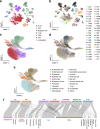Building a learnable universal coordinate system for single-cell atlas with a joint-VAE model
- PMID: 39134617
- PMCID: PMC11319358
- DOI: 10.1038/s42003-024-06564-0
Building a learnable universal coordinate system for single-cell atlas with a joint-VAE model
Abstract
A universal coordinate system that can ensemble the huge number of cells and capture their heterogeneities is of vital importance for constructing large-scale cell atlases as references for molecular and cellular studies. Studies have shown that cells exhibit multifaceted heterogeneities in their transcriptomic features at multiple resolutions. This nature of complexity makes it hard to design a fixed coordinate system through a combination of known features. It is desirable to build a learnable universal coordinate model that can capture major heterogeneities and serve as a controlled generative model for data augmentation. We developed UniCoord, a specially-tuned joint-VAE model to represent single-cell transcriptomic data in a lower-dimensional latent space with high interpretability. Each latent dimension can represent either discrete or continuous feature, and either supervised by prior knowledge or unsupervised. The latent dimensions can be easily reconfigured to generate pseudo transcriptomic profiles with desired properties. UniCoord can also be used as a pre-trained model to analyze new data with unseen cell types and thus can serve as a feasible framework for cell annotation and comparison. UniCoord provides a prototype for a learnable universal coordinate framework to enable better analysis and generation of cells with highly orchestrated functions and heterogeneities.
© 2024. The Author(s).
Conflict of interest statement
The authors declare no competing interests.
Figures




Similar articles
-
scBOL: a universal cell type identification framework for single-cell and spatial transcriptomics data.Brief Bioinform. 2024 Mar 27;25(3):bbae188. doi: 10.1093/bib/bbae188. Brief Bioinform. 2024. PMID: 38678389 Free PMC article.
-
Extracting a biologically relevant latent space from cancer transcriptomes with variational autoencoders.Pac Symp Biocomput. 2018;23:80-91. Pac Symp Biocomput. 2018. PMID: 29218871 Free PMC article.
-
Continually adapting pre-trained language model to universal annotation of single-cell RNA-seq data.Brief Bioinform. 2024 Jan 22;25(2):bbae047. doi: 10.1093/bib/bbae047. Brief Bioinform. 2024. PMID: 38388681 Free PMC article.
-
Application of Computational Biology to Decode Brain Transcriptomes.Genomics Proteomics Bioinformatics. 2019 Aug;17(4):367-380. doi: 10.1016/j.gpb.2019.03.003. Epub 2019 Oct 23. Genomics Proteomics Bioinformatics. 2019. PMID: 31655213 Free PMC article. Review.
-
Single-Cell Sequencing Methodologies: From Transcriptome to Multi-Dimensional Measurement.Small Methods. 2021 Jun;5(6):e2100111. doi: 10.1002/smtd.202100111. Epub 2021 Apr 17. Small Methods. 2021. PMID: 34927917 Review.
Cited by
-
Variational inference of single cell time series.bioRxiv [Preprint]. 2025 May 16:2024.08.29.610389. doi: 10.1101/2024.08.29.610389. bioRxiv. 2025. PMID: 39257806 Free PMC article. Preprint.
References
Publication types
MeSH terms
Grants and funding
LinkOut - more resources
Full Text Sources

